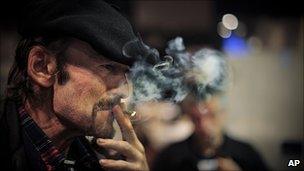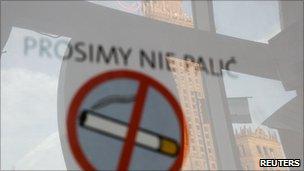Smoking curbs: The global picture
- Published
A guide to smoking bans around the world as governments seek to improve the health of their populations.
Australia
The state of Western Australia introduced the strictest anti-smoking laws in the country in September 2010, with bans in cars carrying children, on sections of beaches and within 10m (32ft) of playground equipment.
Australia also plans to force tobacco companies to use plain packaging carrying graphic health warnings from July 2012.
Across the country, smoking is already banned inside all airports, government offices, health clinics and workplaces.
New Zealand
New Zealand has announced a ban on smoking throughout prisons from July 2011.
Officials said high levels of smoking were a risk to staff and prisoners, and they dismissed concerns that the ban would spark violence. It is believed that two-thirds of the New Zealand's prison population are smokers.
New Zealand already bans smoking in bars, clubs, restaurants, offices, workplaces and shops, and on public transport.
Canada
Canada's strict anti-smoking laws have been credited with cutting hospital admissions for heart and respiratory problems by about a third.
A study published in the Canadian Medical Association Journal in April 2010 monitored admissions in the city of Toronto since smoking bans were introduced in 2001.
Smoking levels in Canada have long been among the lowest in the world, with about 21% of Canadians over the age of 15 reported to be smokers in 2002, according to government statistics.
In addition to bans on smoking in workplaces and many public places, cigarette packets bear graphic images of the damage done to internal organs by smoking.
China
China banned smoking in hospitals in May 2010 but activists say there have seen no signs of the government introducing a promised national ban on smoking in public places.
Many Chinese cities have their own regulations on where people can light up, but enforcement is varied.
A government survey in August showed that only a quarter of the adult population believed that smoking increased the risk of cancer. Anti-smoking campaigns are failing to influence them, state news agency Xinhua reported.
In May 2008, in the run-up to the Olympic Games, a smoking ban for most public buildings came into force in the Chinese capital, Beijing. The country has an estimated 350 million smokers. For every three cigarettes lit worldwide, one is smoked in China.
Syria
In April 2010 Syria become the first Arab state to ban smoking in public places including restaurants and cafes.
The law also prohibits smoking in educational institutions, health centres, sports halls, cinemas and theatres, and on public transport.
The restrictions include the nargile, or hubble-bubble pipe, which is popular among locals and tourists.
Egypt
Egypt took its first steps in introducing a smoking ban earlier this year.
In July, the city of Alexandria began enforcing an existing law - usually flouted - that banned smoking in government buildings. Officials said they aimed to extend the ban to the city's cafes within two years.
Egypt is the biggest consumer of cigarettes in the Arab world, puffing its way through some 19 billion cigarettes every year.
Europe
Greece has long been regarded as Europe's biggest smoking nation and has struggled to make its citizens kick the habit. In September 2010 a fresh attempt was made with a law banning tobacco advertising and smoking in enclosed public spaces.

Critics of Spain's anti-smoking laws say bars will lose business as a result
In 2009 smoking was prohibited in hospitals and schools, vehicles and all public spaces but it was largely ignored in many areas.
Previous attempts to introduce a ban in 2002 and 2003 also failed.
Spain already has anti-smoking laws but tougher rules were announced in October which will give the country some of the strictest legislation in Europe. Lighting up will be banned in bars, cafes and restaurants and extend to open areas near hospitals, schools and children's playground. The new rules are due to come into effect in January.
Poland brought in anti-smoking laws in November 2010. The ban covers schools, museums, theatres, airports and railway and bus stations, public transport, stadiums, hospitals and playgrounds. Smoking is also banned in one-room restaurants and bars.
Estonia joined those European countries banning smoking in bars and restaurants on 5 June, 2007. The law bans smoking in cafes, restaurants, bars, nightclubs - except for special zones - and at bus stops and underground train stations. Offenders face a fine of 80 euros, while owners of cafes and restaurants can face a fine of up to 2,000 euros.
Finland introduced a similar measure on 1 June 2009.
France took a major step towards a total public ban when it announced it would prevent smoking in workplaces and other public buildings from 1 February 2007.
The law was extended in 2008 to include cafes, restaurants and bars.
Its first serious move to cut smoking levels came in October 2003, when it raised the price of cigarettes by 20%.
Correspondents say attitudes to smoking have changed dramatically in France since the 2007 ban, and any fears that people would generally ignore the laws have proved false.

Poland has joined a long list of countries to ban smoking in public places
In Germany, eight states, including Berlin, ushered in 2008 declaring their pubs and restaurants smoke-free.
German restaurants and pubs have strongly resisted the bans, not only because of the potential loss of income but partly because of an earlier crackdown on smoking initiated by Adolf Hitler's Nazi regime.
The sensitivity of the issue has prompted the authorities to allow special rooms to be set up purely for smokers.
The toughest rules in Germany have been brought in by Bavaria, where no smoking rooms have been allowed. Lighting up was recently banned at the Oktoberfest Munich beer festival for the first time.
The Republic of Ireland imposed tough anti-smoking legislation in March 2004, banning smoking in pubs, restaurants and other enclosed workplaces.
Anyone caught smoking in a prohibited location now faces a fine of up to 3,000 euros (£2,000).
Italy imposed a ban on smoking in all enclosed public places including bars and restaurants from midnight on 10 January, 2005.
Montenegro: In August 2004, Montenegro - then part of a union with Serbia - decided to introduce a sweeping ban on smoking in public places in the hope of overturning an established culture of smoking in offices, restaurants, bars and on buses.
Tobacco advertising and the portrayal of smoking on television are also banned.
The Netherlands: The Dutch government banned smoking for hotels, restaurants and the catering industry in 2008, but in November 2010 announced that it plans to exempt bars smaller than 70sq m (753sq ft), with no staff other than the owner.
All bars must put up a sign telling customers whether or not it is a smoking establishment.
Health Minister Edith Schippers said consumers "will get more freedom of choice and personnel will remain protected against tobacco smoke".
In Norway a national ban was imposed on smoking in restaurants, bars and cafes from 1 June 2004.
Portugal introduced restrictions on 1 January 2008 but the rules not as tight as some other European countries. Portuguese bars smaller than 100sq m can still opt to allow smoking. Public buildings can still have smoking zones, provided they are clearly signposted and ventilated.
Smoking in Sweden was prohibited in all bars and restaurants from midnight in May 2005.
In the United Kingdom, smoking is banned in nearly all enclosed public spaces - including bars, restaurants and workplaces.
The ban came into force in England in July 2007. Scotland introduced a ban in March 2006, followed by Wales and Northern Ireland in April 2007.
The government also plans to ask tobacco firms to put only basic information and health or picture warnings on their packets. Making packets a plain colour would also protect children from taking up smoking in the first place, it suggests.
India
A ban on smoking in public places came into force in October 2008 in an effort to curb high levels of tobacco addiction.
The law also bans direct and indirect advertising of tobacco products and the sale of cigarettes to children.
Iran
Iran banned tobacco advertising and smoking in public buildings in October 2003 - but analysts say both measures have had little effect.
However, in July 2010 smokers were banned from taking high-ranking jobs in the Iranian government, the news agency ILNA reported.
Statistics show smoking among young Iranians is on the rise.
US
Many cities and states are considering - or already enforcing - bans on smoking. By November 2010, 27 states had banned lighting up in public places.
California has some of the toughest and most extensive anti-smoking legislation anywhere in the world.
A ban on smoking inside or within 1.5m of any public building came into force in 1993 - recently extended to 6m. Smoking is also banned in restaurants, bars and enclosed workplaces - and on beaches - throughout the state.
New York is also set to adopt tought new measures, having banned smoking in bars, clubs and restaurants since March 2003. It is now set to extend the smoking ban to municipal parks, beaches and pedestrian areas, including the one in Times Square.
Anti-smoking laws have provoked a strong debate in the US. Some bar owners say their businesses are suffering and smokers say their rights are being infringed, while non-smokers say they enjoy the smoke-free environment.
Russia
The Russian government has announced plans to ban advertising and promotion of cigarettes from 2011 and to introduce a complete ban on smoking in enclosed spaces by 2015.
The addiction kills up to 500,000 people a year in the country, Russia's RIA Novosti news agency reports.
A 2009 survey by the World Health Organization found that Russia has 43.9 million smokers - about 40% of the population. The survey also revealed that 60% of Russian men and 22% of Russian women smoke.
Uruguay
Uruguay - which recently hosted an international summit tobacco control - has introduced some of the world's toughest anti-tobacco policies, banning smoking in private as well as public enclosed spaces.
It requires 80% of every cigarette package to show graphic images of the consequences of smoking, including diseased lungs and rotten gums.
Kenya
In the capital, Nairobi, a ban on smoking in indoor public places came into force in July 2007, with a similar ban in Mombasa and the Rift Valley town of Nakuru.
Anyone smoking in offices, bus stations, airports and sports venue faces a fine of 50,000 Kenya shillings ($700; £375) or six months in prison.
Bars and restaurants without separate smoking areas are also affected.
Tanzania
Tanzania banned smoking in many public places in July 2003, with smoke-free zones declared on public transport, as well as in schools and hospitals.
The government also banned the selling of tobacco to under-18s and advertising on radio and television and in newspapers.
Bhutan
Bhutan says it is determined to become the world's first smoking-free nation. It banned the sale of tobacco in 2004 and smoking in public places in 2005.
The country's draconian law gives police sweeping powers to enter homes and search for tobacco products. In addition, it gives them the power to jail shopkeepers for selling tobacco and to arrest smokers if they fail to provide customs receipts for imported cigarettes - which are only permitted in very small quantities.
Smokers can legally import only up to 200 cigarettes or 150g (5.3oz) of other tobacco products a month - but a 100% tax is charged on such products. People found in possession of tobacco must provide a customs receipt when challenged by police, and can face jail for smuggling if they fail to provide their receipts.
There is a cash fine for breaking the ban, and shops also stand to lose their licence.
- Published24 November 2011
- Published21 October 2010
- Published28 June 2010
- Published10 June 2010